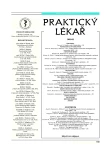Therapeutic protocol of invasive meningococcal disease (IMD) The Therapeutic protocol of invasive meningococcal disease (IMD) is intended for hospital
Authors:
E. Kasal; L. Rožnovský; P. Křížová; O. Džupová; V. Dostál; V. Štruncová; I. Chytra; D. Barnetová; T. Habanec; S. Plíšek; P. Chalupa
Authors‘ workplace:
Hlavní řešitel doc. MUDr. E. Kasal, CSc., přednosta ARK FN Plzeň
; Řešitelská skupina grantu IGA MZ ČR NI-7109-3: Prognostické faktory invazivního meningokokového onemocnění a jejich vliv na
strategii léčby (2002–2004)
Published in:
Prakt. Lék. 2005; 85(4): 196-199
Category:
Various Specialization
Overview
The Therapeutic protocol of invasive meningococcal disease (IMD) is intended for hospital treatment at departments of infectious diseases, pediatric departments, intensive care units and critical care units of departments of anaesthesiology, resuscitation and intensive care. Therapy of severe forms of IMD should be carried out in special centers with complete diagnostic and therapeutic servis available. Timely initiation of therapy is a basic condition for a favorable outcome. Delayed therapy till the moment of admission in a special center is a big mistake. This protocol was developed in extention of the IMD therapeutic protocol for urgent prehospital care published in 2002.
In the introduction of the therapeutic protocol there are described characteristics of the clinical picture and IMD is classified according to its clinical forms. The initial resuscitation of adult and paediatric patients follows. Diagnostic procedures protocol is realized in parallel with initial resuscitation. During assessment of the patient’s general condition it is necessary to evaluate signs typical for severe forms of IMD. Their presence is an indication for admission of the patient to the intensive or critical care unit. Antibiotic therapy introduced within 30 minutes from the first suspicion of IMD represents the basic priority. A review of hemodynamic parameters under monitoring follows with their target values. In addition to volume therapy, possibilities of catecholamin circulatory support, indications for ventilatory support, corticosteroid therapy, possibilities of therapy of emocoagulation disorders, therapy of intracranial hypertension and additional therapeutic procedures are included.
Key words:
invasive meningococcal disease – IMD – therapeutic protocol – hospital treatment.
Labels
General practitioner for children and adolescents General practitioner for adultsArticle was published in
General Practitioner

2005 Issue 4
Most read in this issue
- The aggressive patient
- Benign cutaneous pigmented lesions and the various possibilities in their examination
- Genetics and ethics – past, present, and future
- Musculoskeletal complaints at work with the computer
